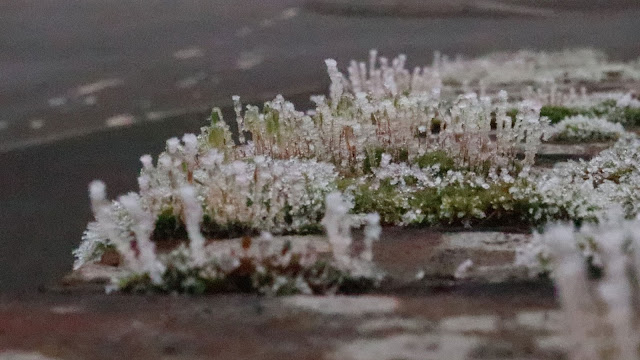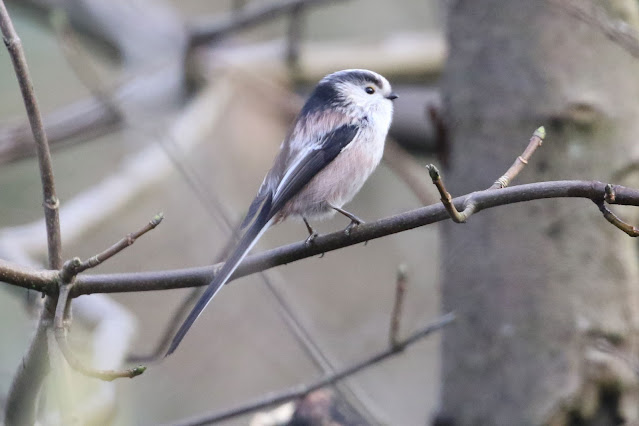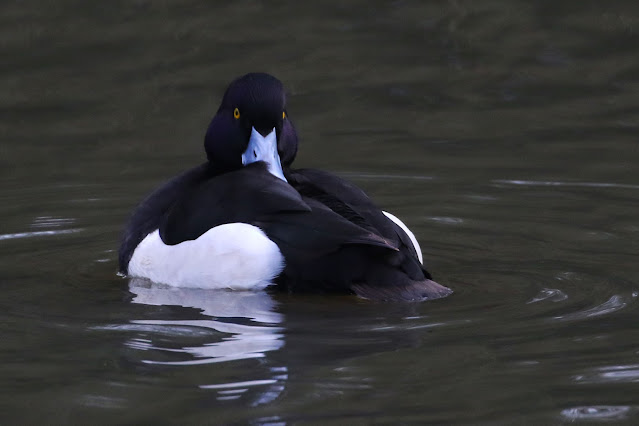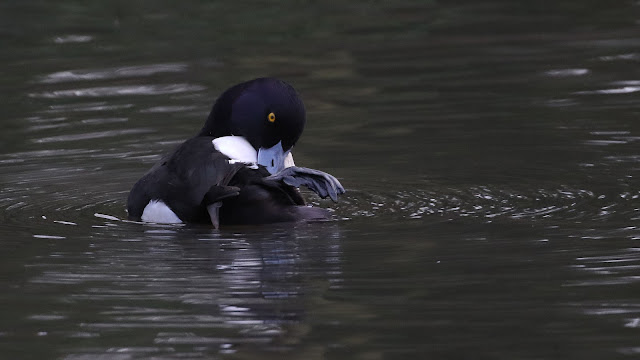We moved into week two of the latest lockdown with a very cold day and a hoar frost. At dawn there was little visible frost around, but as the day moved on the trees and grass started to turn a frosty white. Cobwebs appeared on the hedges where they hadn't been visible before.
While the grass developed a frosting
The wall in the front garden is covered in moss and the frost appeared here creating some beautiful patterns.
The weather for the start of the week though saw a return to mild and wet conditions, this restricted my daily walks but I did manage to get out towards the end of the week. A walk at the end of last week to the pond did not produce the hoped for Tufted Duck that had been there at the end of last year. However a quick visit on Thursday found the drake Tufted Duck out in the long with the Mallard. It was dull and gloomy, and dark water and a virtually black duck meant these shots were a little grainy.
Saturday saw heavy rain overnight and into the morning. The threat of snow though did not materialise and by midday the sun had broken through and it and a fresh wind made it good enough to be able to get out.
It was extremely quiet in the wood as it is at this time of year, every so often there would be a burst of Robin, and contact calls would come from the highest branches. I stopped to watch a pair of Nuthatches evade my camera, while a Treecreeper put in a brief appearance confirmed by this record shot.
Four species of Tit were heard and seen, Great, Blue, Marsh and Coal, a trip to the Tawny Owl's tree of previous years did not find anything, but then it is a little early, it doesn't usually appear until February.
I was taken by the bare trees and the blue sky and white clouds. It creates a lovely pattern looking up.
Moving back to the pond the arrival of a family, intent on feeding the ducks, had pushed all the Mallard and the Tufted Duck away from the reeds and vegetation into the centre of the pond. The light today was much better so it was fill your boots time.
Tufted ducks are one of the commonest diving ducks in the United Kingdom, feeding on aquatic plants, insects and molluscs, a small fact, the increased distribution of the Tufted Duck at the start of the 20th century was attributed to the introduction of the zebra mollusc.
On one or two occasions I noticed it spending time with a female Mallard which was much to the annoyance of the drake Mallards. It would also turn its head to look skywards, maybe this is just a reflex,.
You can have too much though and I decided it was time to move on, as I left the pond I paused to capture the whole of the pond.
Back home there have been some changes, the Robins have become more approachable watching as I put out the meal worms and daring to come close. The tame Robin we called Donald is still about holding territory on the right hand side of the garden, he can be identified by the ridge in his feathers behind the ear coverts.
A addition to the garden is a Wren that has taken a liking to the meal worms, so much so that it seems to look out for me when I top up the trays, appearing almost immediately. It will also appear even if I don't top them up, coming to inspect the trays.
It usually takes three of four worms depending on whether or not it is disturbed by another bird. It will take them under the log to kill and then eat. Quite a substantial meal for a little bird.
From the pond we made our way home, a Red Kite the only bird of interest as we reached the crossroads with Lymington Bottom.
The air was still cool, but the lunch time sun was very welcome. As we walked towards Chalk Close I noticed a bird fly up from the lawn of the house on the corner. At first I thought it was one of the many Robins around, but then I noticed the tail flicking. It couldn't be could it? It was, a Black Redstart.
Then as I attempted to get closer it flew up and over the house and away into the garden. After letting Helen back into the house I returned to try and find it to get some more shots. This was a brilliant find, I have highlighted in my check list the birds I would have a hope of seeing around the patch, but never considered Black Redstart, however today there seem to be more appearing in the winter on housing estates.
The Latin genus name, Phoenicurus, means Red-tailed, while the specific name, Ochruros, means pale yellow, which is more the colour in the female.
From there it went to the top of the roof where I was able to watch it from the garden, taking the garden list to 64 and the Four Marks patch list to 107.
















































No comments:
Post a Comment
Note: only a member of this blog may post a comment.